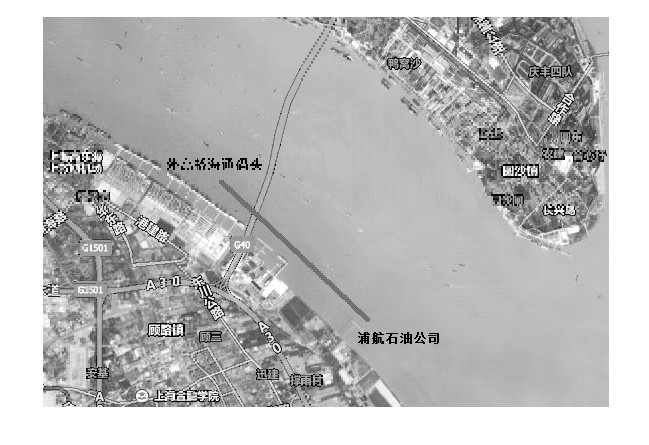Cruise speed optimization of tugboat based on real fuel consumption and emission
-
摘要: 利用便携式排放测试系统对上海外高桥港近海拖轮进行了油耗与排放测试, 拟合了油耗、排放与航速的关系, 建立了巡航工况下的航速优化模型, 分析了拖轮最佳油耗和排放对应的航速。试验结果表明: 船舶CO2的排放因子与燃油的品质和船舶工况相关, 与实船排放测试相比, 使用经验排放因子估算排放率是可行的; 当使用幂函数拟合CO、CO2、THC、NOx、PM、PN排放和油耗与航速关系时, 各拟合曲线的决定系数均大于0.9;仅对油耗优化, 当航速为7.21kn时, 拖轮单次巡航工况下的总油耗达到最小值, 相对最大航速12.00kn的油耗下降了33.40%;对油耗和NOx排放进行优化, 得到的最优航速最大; 对油耗与所有排放同时优化, 得到的最优航速最小; 当航速为6.96kn时, 拖轮的总油耗、NOx、PM和PN总排放达到最优值, 相对最大航速, 总油耗下降了33.29%, CO、CO2、THC、NOx、PM、PN减排率分别达到59.56%、76.37%、82.34%、92.36%、53.10%和62.25%。可见, 在最优航速时, 拖轮总油耗与总排放均显著减小。Abstract: The test of fuel consumption and emission of offshore tugboat in Shanghai Waigaoqiao Port was conducted by using portable emission measurement system, the relationship between fuel consumption, emission and cruise speed was fitted, an optimization model of cruise speed was established, and the optimal fuel consumption and emission of tugboat and corresponding speed were analyzed.Test result shows that CO2 emission factor is related to fuel quality and working condition of ship, and the accurate emission result can be obtained by estimating based on empirical emission factor comparing with real-ship emission test.When power function is used to fit the relationship between the emissions of CO, CO2, THC, NOx, PM and PN, fuel consumption and cruise speed, the determination coefficient of each fitting curve is larger than0.9.Under the condition that fuel consumptionis optimized, when cruise speed is 7.21 kn, the total fuel consumption of tugboat in single cruise condition reaches the minimum and decreases by33.40% compared to the maximum cruise speed of 12.00 kn.The optimal cruise speed reachesthe maximum while both fuel consumption and NOxemission are optimized.The optimal cruise speed reaches the minimum while both fuel consumption and all emissions are optimized.When cruise speed is 6.96 kn, the total fuel consumption and emission of NOx, PM and PN reach the optimal values, compared to the maximum cruise speed, the total fuel consumption decreases by33.29%, and the emission reduction rates of CO, CO2, THC, NOx, PM, PN are 59.56%, 76.37%, 82.34%, 92.36%, 53.10%, 62.25% respectively. Obviously, the total fuel consumption and emissions of tugboat decrease significantly at optimal cruise speed.
-
Key words:
- ship engineering /
- tugboat /
- curise speed optimization /
- emission test /
- fuel consumption
-
表 1 拖轮主要参数
Table 1. Main parameters of tugboat

表 2 拖轮燃油参数
Table 2. Fuel parameters of tugboat

表 3 排放与油耗测试结果
Table 3. Test result of emission and fuel consumption

表 4 不同优化目标下最优航速
Table 4. Optimal speeds under different optimization objectives

-
[1] KHLER J. Globalization and sustainable development: case study on international transport and sustainable development[J]. Journal of Environment and Development, 2014, 23 (1): 66-100. doi: 10.1177/1070496513507260 [2] BLASCO J, DURN-GRADOS V, HAMPEL M, et al. Towards an integrated environmental risk assessment of emissions from ships'propulsion systems[J]. Environment International, 2014, 66 (3): 44-47. [3] CORBETT J J. New directions: designing ship emissions and impacts research to inform both science and policy[J]. Atmospheric Environment, 2003, 37 (33): 4719-4721. doi: 10.1016/j.atmosenv.2003.08.003 [4] MARMER E, LANGMANN B. Impact of ship emissions on the Mediterranean summertime pollution and climate: a regional model study[J]. Atmospheric Environment, 2005, 39 (26): 4659-4669. doi: 10.1016/j.atmosenv.2005.04.014 [5] 秦琦, 祁斌, 沈苏雯, 等. 2014年世界船舶市场评述及2015年展望[J]. 船舶, 2015 (1): 1-14. https://www.cnki.com.cn/Article/CJFDTOTAL-CBZZ201501001.htmQIN Qi, QI Bin, SHEN Su-wen, et al. Review of world ship market in 2014and beyond[J]. Ship and Boat, 2015 (1): 1-14. (in Chinese). https://www.cnki.com.cn/Article/CJFDTOTAL-CBZZ201501001.htm [6] YAN F, WINIJKUL E, STREETS D G, et al. Global emission projections for the transportation sector using dynamic technology modeling[J]. Atmospheric Chemistry and Physics, 2014, 14 (11): 5709-5733. doi: 10.5194/acp-14-5709-2014 [7] ARMSTRONG V N. Vesseloptimisation for low carbon shipping[J]. Ocean Engineering, 2013, 73: 195-207. doi: 10.1016/j.oceaneng.2013.06.018 [8] WANG Shuai-an, MENG Qiang, LIU Zhi-yuan. Bunker consumption optimization methods in shipping: A critical review and extensions[J]. Transportation Research Part E: Logistics and Transportation Review, 2013, 53 (1): 49-62. [9] FAGERHOLT K, GAUSEL N T, RAKKE J G, et al. Maritime routing and speed optimization with emission control areas[J]. Transportation Research Part C: Emerging Technologies, 2015, 52: 57-73. doi: 10.1016/j.trc.2014.12.010 [10] WONG E Y C, TAI A H, LAU H Y K, et al. An utilitybased decision support sustainability model in slow steaming maritime operations[J]. Transportation Research Part E: Logistics and Transportation Review, 2015, 78: 57-69. doi: 10.1016/j.tre.2015.01.013 [11] KONTOVAS C, PSARAFTIS H N. Reduction of emissions along the maritime intermodal container chain: operational models and policies[J]. Maritime Policy and Management, 2011, 38 (4): 451-469. doi: 10.1080/03088839.2011.588262 [12] LINDSTAD H, ASBJØRNSLETT B E, JULLUMSTRØE. Assessment of profit, cost and emissions by varying speed as a function of sea conditions and freight market[J]. Transportation Research Part D: Transport and Environment, 2013, 19 (1): 5-12. [13] CORBETT J J, WANG Hai-feng, WINEBRAKE J J. The effectiveness and costs of speed reductions on emissions from international shipping[J]. Transportation Research Part D: Transport and Environment, 2009, 14 (8): 593-598. doi: 10.1016/j.trd.2009.08.005 [14] 姬钰. 上海港港作拖轮配置规划分析研究[D]. 上海: 上海交通大学, 2011.JI Yu. Analysis of planning and configuration of Shanghai harbor tugs[D]. Shanghai: Shanghai Jiaotong University, 2011. (in Chinese). [15] PAPSON A, HARTLEY S, BROWNING L. Cost effectiveness of five emission reduction strategies for inland river tug and towboats[J]. Applied Biochemistry and Biotechnology, 2010, 80 (2): 107-120. [16] JAYARAM V, AGRAWAL H, WELCH W A, et al. Realtime gaseous, PM and ultrafine particle emissions from a modern marine engine operating on biodiesel[J]. Environmental Science and Technology, 2011, 45 (6): 2286-2292. doi: 10.1021/es1026954 [17] HALLQUISTÅM, FRIDELL E, WESTERLUND J, et al. Onboard measurements of nanoparticles from a SCR-equipped marine diesel engine[J]. Environmental Science and Technology, 2012, 47 (2): 773-780. [18] WINNES H, MOLDANOVÁJ, ANDERSON M, et al. Onboard measurements of particle emissions from marine engines using fuels with different sulphur content[J]. Journal of Engineering for the Maritime Environment, 2016, 230 (1): 45-54. [19] FU Ming-liang, DING Yan, GE Yun-shan, et al. Real-world emissions of inland ships on the grand canal, China[J]. Atmospheric Environment, 2013, 81 (4): 222-229. [20] ANDERSON M, SALO K, FRIDELL E. Particle-and gaseous emissions from an LNG powered ship[J]. Environmental Science and Technology, 2015, 49 (20): 12568-12575. doi: 10.1021/acs.est.5b02678 [21] FRIDELL E, SALO K. Measurements of abatement of particles and exhaust gases in a marine gas scrubber[J]. Journal of Engineering for the Maritime Environment, 2016, 230 (1): 154-162. [22] 张学敏, 葛蕴珊, 张昱, 等. 利用碳平衡法进行汽车油耗测量的应用研究[J]. 车用发动机, 2005 (3): 56-58. https://www.cnki.com.cn/Article/CJFDTOTAL-CYFD20050300H.htmZHANG Xue-min, GE Yun-shan, ZHANG Yu, et al. Research on fuel consumption measurement using carbon balance method[J]. Vehicle Engine, 2005 (3): 56-58. (in Chinese). https://www.cnki.com.cn/Article/CJFDTOTAL-CYFD20050300H.htm [23] WANG Shuai-an, MENG Qiang. Sailing speed optimization for container ships in a liner shipping network[J]. Transportation Research Part E: Logistics and Transportation Review, 2012, 48 (3): 701-714. [24] 许欢, 刘伟, 张爽. 低碳经济下船舶航行速度选择[J]. 中国航海, 2012, 35 (2): 98-101, 109. https://www.cnki.com.cn/Article/CJFDTOTAL-ZGHH201202023.htmXU Huan, LIU Wei, ZHANG Shuang. Choice of ship speeds under low-carbon economy[J]. Navigation of China, 2012, 35 (2): 98-101, 109. (in Chinese). https://www.cnki.com.cn/Article/CJFDTOTAL-ZGHH201202023.htm [25] CHANG C C, WANG C M. Evaluating the effects of speed reduce for shipping costs and CO2emission[J]. Transportation Research Part D: Transport and Environment, 2014, 31 (8): 110-115. -





 下载:
下载:













